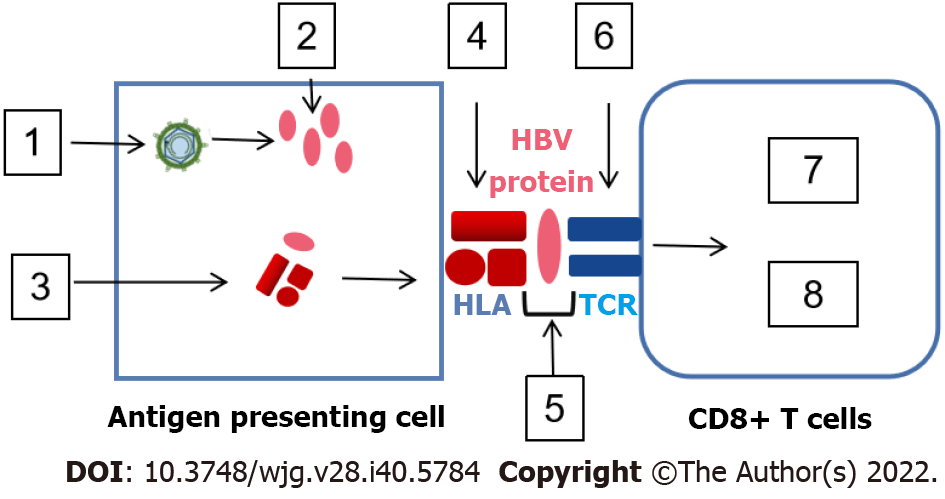Copyright
©The Author(s) 2022.
World J Gastroenterol. Oct 28, 2022; 28(40): 5784-5800
Published online Oct 28, 2022. doi: 10.3748/wjg.v28.i40.5784
Published online Oct 28, 2022. doi: 10.3748/wjg.v28.i40.5784
Figure 2 Mechanism of immune escape in antigen-presenting cell/hepatitis B virus special T-cell.
Hepatitis B virus (HBV)-infected hepatocytes produce various HBV antigens that are swallowed and digested by antigen-presenting cells (APCs), producing HBV peptide/human leukocyte antigen (HLA) complexes. Antigen processing escape mutants, down-regulating HLA expression and mutation of HLA binding residues may appear in APCs. The HBV peptide/HLA complexes are transferred to the surface of APC and make contact with T-cell receptor (TCR) on the surface of CD8+ T-cells. Masking HLA/TCT binding residues with N-linked glycosylation and mutation of TCR binding residues influences TCR affinity/avidity, leading to CD8+ T-cell stimulation or inhibition. The square icon displays: (1) Increase in viral antigen; (2) Antigen processing escape mutants; (3) Down-regulation of HLA expression; (4) Mutation of HLA binding residues; (5) Masking of HLA/TCT binging residues with N-linked glycosylation; (6) Mutation of TCR binding residues; (7) Stimulation induced by cytokine production and cytolytic activity; and (8) Inhibition caused by exhaustion, anergy and tolerance. HBV: Hepatitis B virus; TCR: T-cell receptor; HLA: Human leukocyte antigen.
- Citation: Yin GQ, Chen KP, Gu XC. Heterogeneity of immune control in chronic hepatitis B virus infection: Clinical implications on immunity with interferon-α treatment and retreatment. World J Gastroenterol 2022; 28(40): 5784-5800
- URL: https://www.wjgnet.com/1007-9327/full/v28/i40/5784.htm
- DOI: https://dx.doi.org/10.3748/wjg.v28.i40.5784









